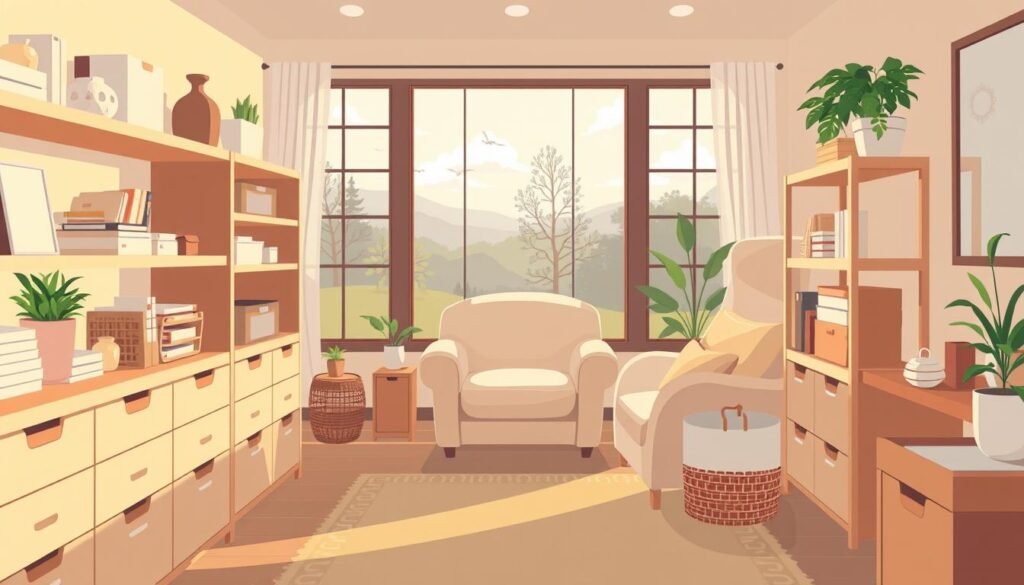Did you know that a cluttered home can increase stress levels and decrease productivity? A tidy space can have a significant impact on both mental and physical well-being. Maintaining a clutter-free home is not just about aesthetics; it’s about creating a peaceful living environment.
By adopting simple steps to declutter and organize your home, you can improve your overall quality of life. Home organization is not just a one-time task, but a continuous process that requires commitment and the right strategies.
Key Takeaways
- Understand the benefits of a clutter-free home
- Learn simple steps to declutter and organize your space
- Discover strategies for maintaining a tidy home
- Improve your mental and physical well-being
- Adopt a minimalist living approach for a more peaceful life
The Psychology Behind Clutter
Understanding the psychology behind clutter is crucial for effective decluttering. Clutter isn’t just a physical issue; it’s deeply intertwined with our mental state.
How Clutter Affects Mental Health
Clutter can significantly impact our mental health, leading to feelings of overwhelm and anxiety. A cluttered environment can make it difficult to focus and relax, contributing to increased stress levels.
The Connection Between Physical Space and Mental Space
The state of our physical surroundings can mirror our mental state. By decluttering and improving our physical space, we can also enhance our mental clarity and well-being. As noted, “decluttering isn’t just about getting rid of things. It’s about choosing what stays. It’s about curating a home that reflects who you are and how you want to live.” This process of organization can be therapeutic, promoting a sense of control and calm.
Benefits of a Decluttered Home
A decluttered home is more than just a tidy space; it’s a foundation for a healthier lifestyle. The process of decluttering and organizing can have a profound impact on various aspects of our lives, from mental health to daily productivity.
Reduced Stress and Anxiety
One of the most significant decluttering benefits is the reduction in stress and anxiety. Clutter can be overwhelming, making it difficult to focus and relax. By removing unnecessary items, individuals can create a more peaceful living environment.
Improved Productivity
A well-organized home can significantly enhance productivity. With a clear space, individuals can better concentrate on tasks and manage their time more efficiently. This is particularly beneficial for those who work from home or have busy schedules.
Better Sleep Quality
Maintaining a decluttered bedroom can lead to better sleep quality. A clutter-free environment promotes relaxation, making it easier to fall asleep and stay asleep throughout the night.
| Benefits | Description |
|---|---|
| Reduced Stress | Less clutter leads to a more peaceful environment, reducing stress and anxiety. |
| Improved Productivity | A well-organized space enhances focus and efficiency. |
| Better Sleep | A clutter-free bedroom promotes relaxation and improves sleep quality. |
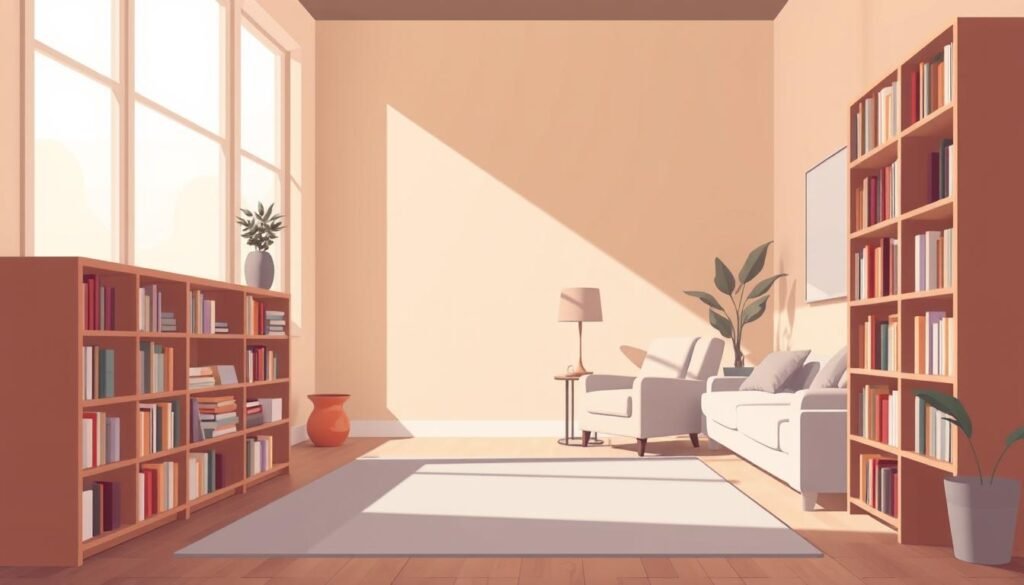
As one source aptly puts it, “there’s no better feeling than the satisfaction of having a freshly organized space!” This sentiment underscores the positive impact of decluttering on our overall well-being.
Preparing Your Mindset for Decluttering Success
Before diving into decluttering, it’s essential to prepare your mindset for the task ahead. A clutter-free home is not just about getting rid of stuff; it’s about creating a space that reflects your values and supports your well-being.
Setting Realistic Expectations
To start, set a goal that feels manageable. As one source advises, “Before you start decluttering, take a moment to decide which areas need the most attention… Set a goal that feels manageable.” This could mean decluttering one room at a time or dedicating a specific amount of time each day to the task.
Overcoming Emotional Attachments to Objects
Many people struggle with emotional attachments to their possessions. It’s essential to acknowledge these feelings and develop strategies to overcome them. This might involve creating memory boxes for sentimental items or finding alternative ways to remember happy times.
Creating a Positive Attitude Toward Change
Fostering a positive attitude toward change is crucial for decluttering success. Focus on the benefits of a decluttered home, such as reduced stress and improved productivity. By maintaining a positive outlook, you’ll be more motivated to continue the decluttering process and maintain your newly organized space.
Essential Decluttering Tools and Supplies
Effective decluttering starts with the right tools and supplies. Having the appropriate materials can make the process more efficient and less overwhelming.
Storage Containers and Organizers
Storage containers and organizers are crucial for keeping items tidy and accessible. Consider using shoe boxes and diaper boxes wrapped in pretty paper for a decorative touch. You can also use plastic bins, baskets, and drawers to categorize and store items.
Labeling Systems
A labeling system is vital for maintaining organization. Labels help identify what’s inside containers, making it easier to find what you need. You can use label makers or simple stickers to label your storage containers.
Donation Bags and Boxes
Having donation bags and boxes on hand encourages you to sort items for charity. Clearly label these containers to avoid confusion.
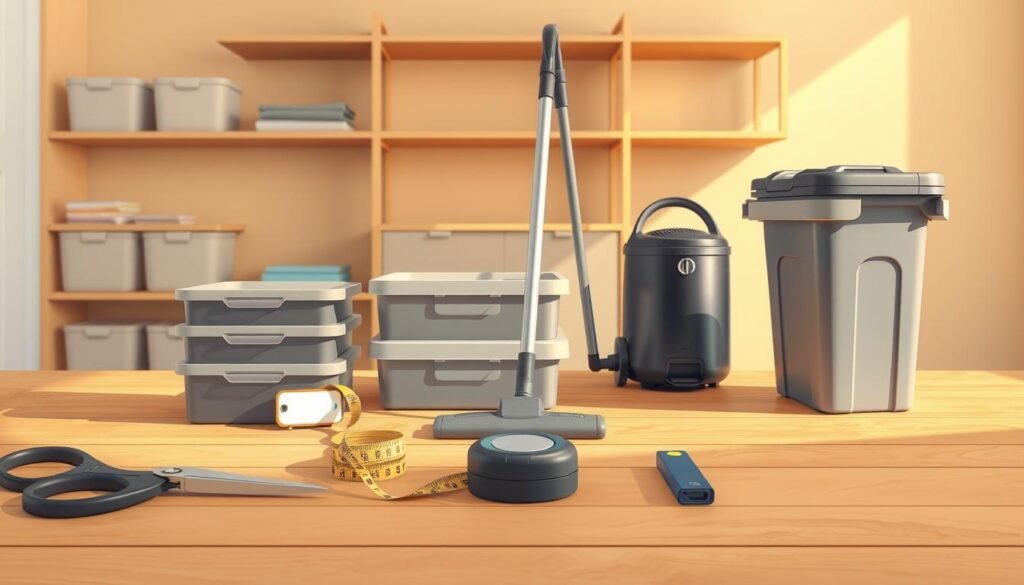
| Tool/Supply | Purpose | Tips |
|---|---|---|
| Storage Containers | Keep items tidy and accessible | Use decorative boxes or bins |
| Labeling Systems | Identify contents of containers | Use label makers or stickers |
| Donation Bags and Boxes | Sort items for charity | Label clearly to avoid confusion |
Effective Decluttering Methods and Systems
Effective decluttering is not just about getting rid of stuff; it’s about creating a system that works for you. With numerous methods available, choosing the right one can make all the difference in achieving a clutter-free home.
The 4-Box Method
The 4-Box Method is a straightforward and efficient decluttering technique. It involves sorting items into four boxes labeled: keep, donate, sell, and discard. This method helps in making quick decisions about what to do with each item, making the decluttering process less overwhelming.
The KonMari Method
The KonMari Method, popularized by Marie Kondo, focuses on keeping items that spark joy. It involves gathering items of a particular category, holding each item, and keeping only those that evoke a positive feeling. This method encourages a mindful approach to decluttering and helps in surrounding yourself with items that bring happiness.
The 12-12-12 Challenge
The 12-12-12 Challenge is a simple yet effective decluttering task. It involves finding 12 items to throw away, 12 items to donate, and 12 items to be returned to their proper place. This challenge is a great way to start decluttering, as it sets achievable goals and helps in developing decluttering habits.
By adopting one or more of these decluttering methods, you can create a system that fits your needs and helps you maintain a tidy and organized home. Whether you’re looking to simplify your space or adopt a more minimalist lifestyle, these methods provide a solid foundation for your decluttering journey.
Room-by-Room Decluttering: The Kitchen
The kitchen is often considered the heart of the home, but when cluttered, it can become a source of stress rather than warmth. A cluttered kitchen not only hampers your cooking efficiency but also affects the overall ambiance of your home. Effective kitchen decluttering involves organizing various areas, including the pantry, cabinets, drawers, and countertops.
Pantry Organization
Pantry organization is a crucial aspect of kitchen decluttering. Start by clearing out expired or unused food items. Use storage containers and baskets to categorize and store food, making it easier to find what you need. Labeling these containers can further enhance the accessibility of your pantry contents.
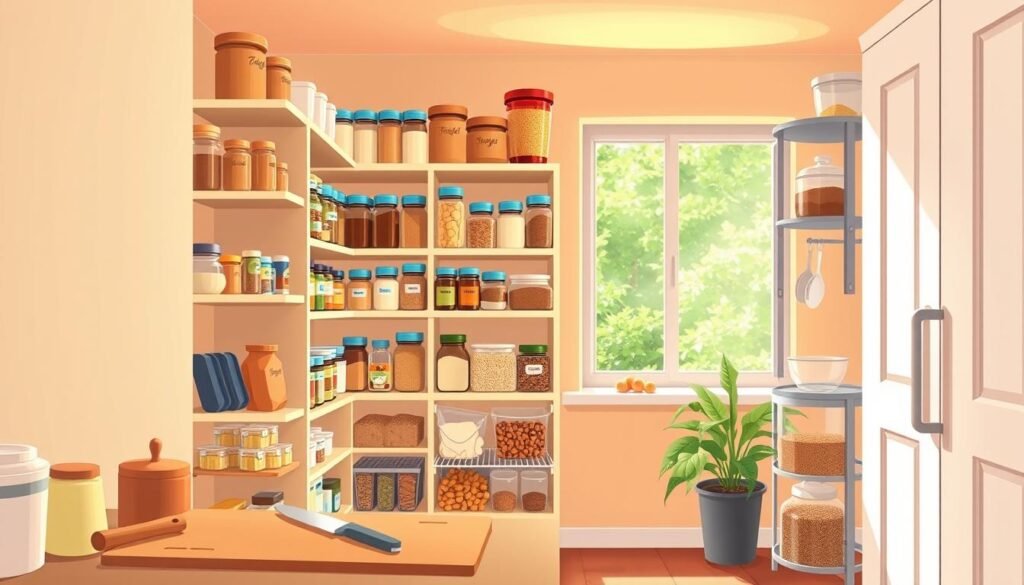
Cabinet and Drawer Systems
Optimizing your cabinet and drawer space is essential for a clutter-free kitchen. Implement dividers in your drawers to separate utensils and cooking tools. For cabinets, consider adjustable shelving to accommodate items of various sizes. This will help maximize storage and reduce clutter.
Countertop Management
Countertop management is vital for maintaining a tidy kitchen. Keep only essential items on your countertops, such as a coffee maker or toaster. Store less frequently used appliances in cabinets or on high shelves. Regularly cleaning your countertops will also help maintain a clutter-free and hygienic kitchen environment.
“A cluttered kitchen is not just an eyesore; it’s a hindrance to your cooking experience and overall home enjoyment.”
By focusing on these areas, you can achieve a well-organized kitchen that enhances your cooking experience and contributes to a more pleasant home environment.
Room-by-Room Decluttering: Bedrooms and Closets
Effective bedroom decluttering is about creating a haven that promotes relaxation and rejuvenation. A clutter-free bedroom is essential for a good night’s sleep and a clear mind. To achieve this, it’s crucial to tackle both the bedroom and closet spaces systematically.
Wardrobe Decluttering Techniques
When it comes to wardrobe decluttering, sorting clothes into categories is a practical first step. Consider the 80/20 rule, where 80% of the time, you likely wear 20% of your clothes. This can help guide your decision-making process.
- Start by removing everything from your closet and sorting items into three piles: keep, donate/sell, and discard.
- Be ruthless about letting go of items that are stained, torn, or no longer fit.
- Consider the last time you wore each item; if it’s been over a year, it’s likely safe to let it go.
Seasonal Clothing Storage
Seasonal clothing storage is key to maintaining a clutter-free closet. Store out-of-season clothes in labeled bins or containers to keep them organized and out of the way.
Tips for Seasonal Storage:
- Clean clothes before storing them to prevent stains from setting in.
- Use breathable storage bags or containers to maintain fabric quality.
- Store items in a cool, dry place to prevent damage.
Maximizing Small Closet Spaces
Maximizing small closet spaces requires creativity and the right tools. Consider using double rods, stackable shelves, and under-shelf storage to make the most of your closet’s dimensions.
By implementing these strategies, you can transform your bedroom and closet into organized, peaceful spaces that enhance your overall well-being.
Room-by-Room Decluttering: Living Areas
Creating a serene living area starts with decluttering and organizing your space. The living room, often considered the heart of the home, is where families and friends gather, making it a priority for decluttering efforts.
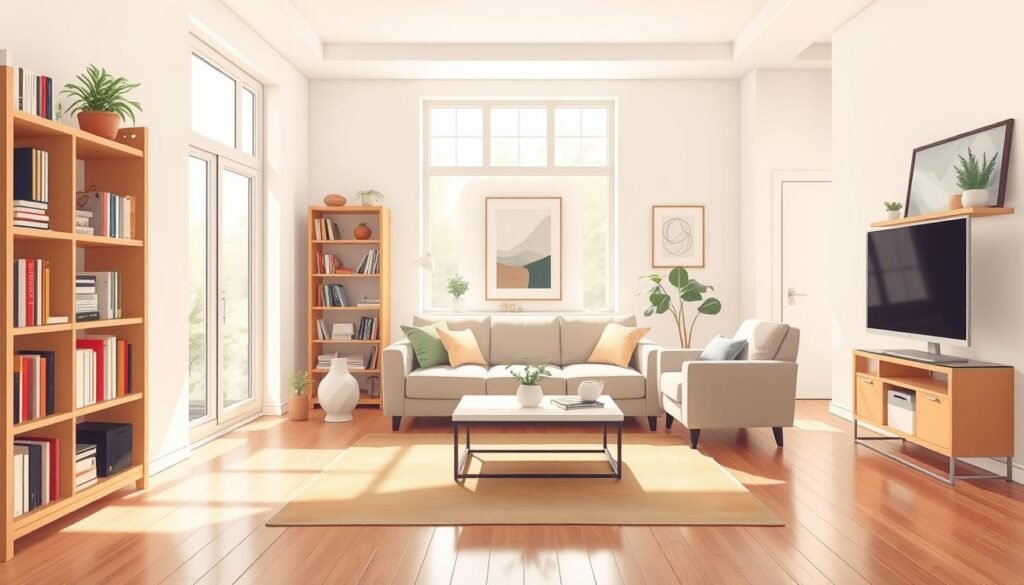
Entertainment Center Organization
Begin by sorting through your entertainment center. Remove any unnecessary cables, outdated electronics, or DVDs you no longer watch. Use cable organizers to keep cords tidy and consider a media storage unit to house your collection.
Bookshelf Management
Bookshelves can quickly become cluttered with books, decorative items, and miscellaneous objects. Start by dusting and removing items that don’t belong. Organize your books by genre or author, and consider donating those you won’t read again. Use bookshelf dividers to keep items categorized.
Toy Organization for Families
For families, toy organization is crucial. Encourage children to participate in decluttering by making it a fun activity. Set a timer and challenge them to collect items for donation. Use toy storage bins and labeling systems to keep toys organized and easily accessible.
By implementing these strategies, you can create a more organized, enjoyable living space that benefits the entire family.
Tackling Paper Clutter and Home Office Spaces
One of the most effective ways to improve your home office’s productivity is by implementing a paper clutter management system. Paper clutter can quickly accumulate, turning your workspace into a chaotic environment that’s difficult to navigate.
To tackle this issue, it’s essential to create a structured approach to managing paper clutter. This involves several key strategies.
Creating a Paper Processing System
Start by setting up a paper processing system that includes a designated area for sorting and dealing with incoming and existing paperwork. This could be a desk drawer or a file organizer where you can categorize documents into different groups, such as bills to pay, documents to file, and papers to recycle or shred.
Digital Document Management
In today’s digital age, converting physical documents into digital format can significantly reduce clutter. Consider using a document scanner or a mobile scanning app to digitize your papers. This not only saves space but also makes it easier to access and manage your documents.
Mail Sorting Strategies
Implementing effective mail sorting strategies is also crucial. Create a routine to immediately sort incoming mail into categories, such as bills, personal letters, and junk mail. Use a paper tray or a mail sorter to keep the mail organized until you can deal with it.
By implementing these strategies, you can significantly reduce paper clutter in your home office, leading to a more organized, productive workspace.
Digital Decluttering in the Modern Home
Digital decluttering is an often-overlooked aspect of maintaining a tidy and organized home. As our lives become increasingly digital, the clutter we’ve traditionally associated with physical spaces has migrated to our online lives.
In the modern home, digital clutter can manifest in various forms, from disorganized digital files and overflowing email inboxes to unused apps and subscriptions. Organizing digital spaces is just as crucial as decluttering physical ones, as it can significantly impact our productivity and mental clarity.
Organizing Digital Photos and Files
One of the first steps in digital decluttering is organizing your digital photos and files. This involves creating a logical folder structure, naming files consistently, and eliminating duplicates or unnecessary files. Consider using cloud storage services like Google Drive, Dropbox, or iCloud to store and access your files from anywhere.
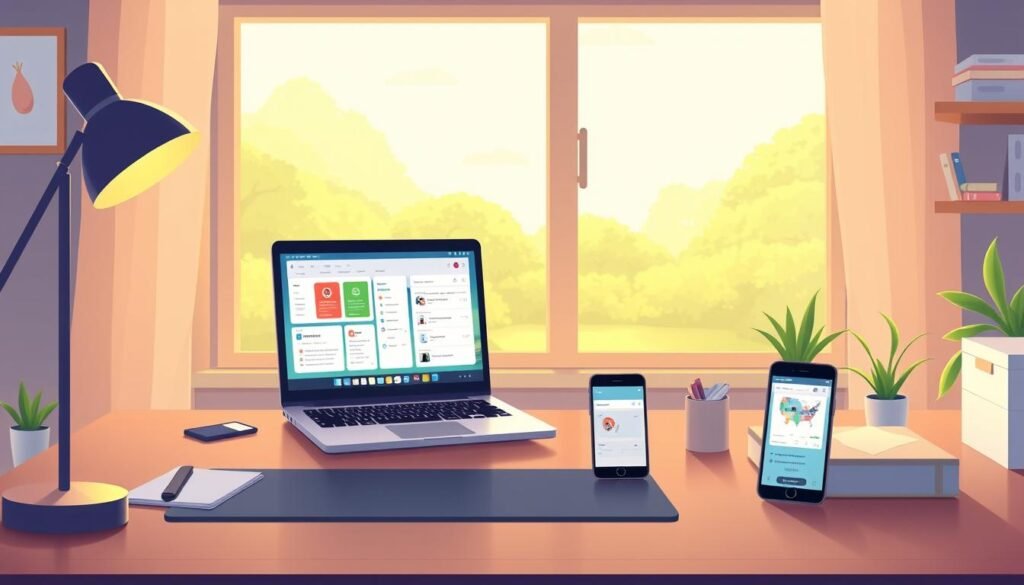
Email Management
Managing your email inbox is another critical aspect of digital decluttering. This can be achieved by unsubscribing from unnecessary newsletters, creating filters to categorize incoming emails, and regularly cleaning out your inbox. Implementing a ‘zero inbox’ policy can be incredibly liberating and help you stay on top of important communications.
Streamlining Apps and Subscriptions
Lastly, streamlining your apps and subscriptions can help reduce digital clutter. Review the apps you use regularly and cancel subscriptions that are no longer needed. Consider using a password manager to keep track of your login credentials and simplify your digital life.
By tackling these areas, you can achieve a more organized digital environment that complements your decluttered physical space, enhancing your overall quality of life.
Sustainable Ways to Dispose of Unwanted Items
Embracing sustainable decluttering practices can significantly reduce waste and benefit the environment. As you declutter, it’s crucial to consider the most eco-friendly ways to dispose of unwanted items, ensuring they don’t end up in landfills.
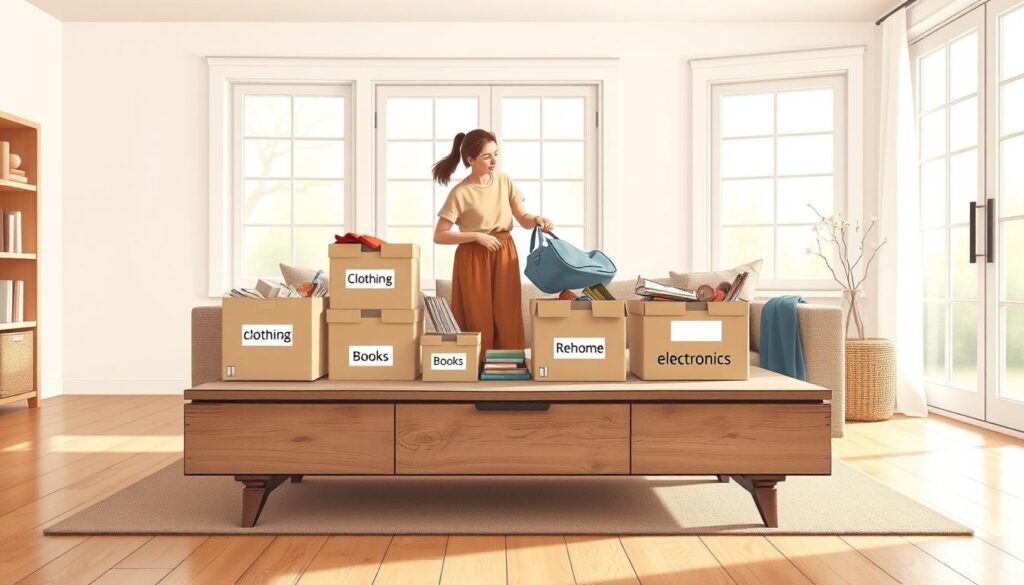
Donation Centers and Charities
Donating gently used items is a great way to give back to the community while decluttering. Many charities and donation centers accept a wide range of items, from clothing and household goods to furniture and electronics.
- Research local charities that accept donations.
- Schedule a pickup or drop off your donations.
- Claim a tax deduction for your generous donations.
Selling Platforms and Strategies
Selling unwanted items can be a profitable way to declutter while making some extra cash. Consider using popular selling platforms like eBay, Craigslist, or Facebook Marketplace.
- Take clear, well-lit photos of your items.
- Write detailed descriptions and set competitive prices.
- Respond promptly to inquiries and negotiate prices when necessary.
Recycling and Upcycling Options
For items that are no longer usable, consider recycling or upcycling as a sustainable alternative to disposal. Many communities have recycling programs for electronics, paper, and other materials.
- Check with your local government for recycling guidelines.
- Get creative with upcycling projects, turning old items into new, useful ones.
- Support businesses that offer upcycling services or products.
By adopting these sustainable decluttering practices, you can make a positive impact on the environment while creating a more organized, clutter-free space.
Conclusion: Maintaining Your Decluttered Home
Now that you’ve decluttered your home, it’s essential to maintain the space to enjoy the benefits of a tidy environment. Setting up systems to maintain your decluttered state is crucial. Regularly checking in to ensure everything remains organized will help you stay on track.
To keep your home organized, create a decluttering checklist and schedule regular tidying sessions. This will help you stay focused and ensure that clutter doesn’t build up again. Consider implementing a “one in, one out” policy to maintain your newly organized space.
Effective home organization is not just about getting rid of clutter, but also about creating habits that maintain your space. By incorporating these strategies into your daily routine, you’ll be able to enjoy the benefits of a decluttered home for years to come.
FAQ
What is the best way to start decluttering my home?
How do I decide what to keep and what to discard?
What are some effective decluttering methods for organizing my kitchen?
How can I maintain my decluttered space over time?
What are some sustainable ways to dispose of unwanted items?
How can I declutter my digital life?
What are some tips for decluttering my bedroom and closet?
How can I involve my family in the decluttering process?
Prabir Dutta
Prabir Dutta is a passionate digital creator, affiliate marketer, and wellness enthusiast who simplifies complex topics like AI tools, Vastu, pet care, and modern living. With a keen eye for SEO, tech trends, and everyday health solutions, he writes to empower readers with actionable, smart-living insights. When not curating content across his network of niche blogs, Prabir enjoys exploring new digital tools that make life easier and more efficient.

